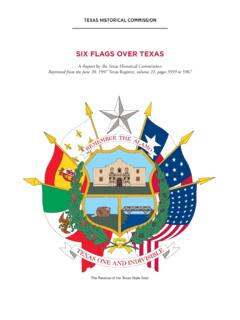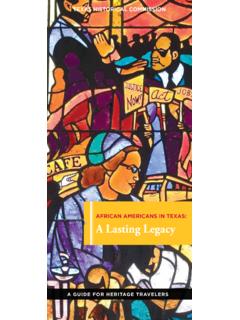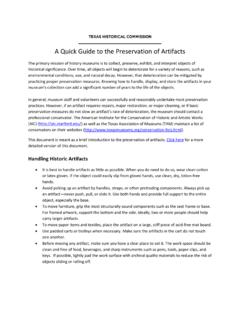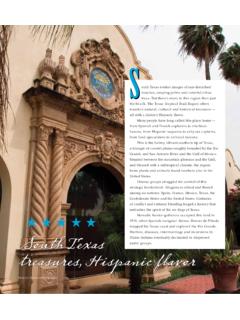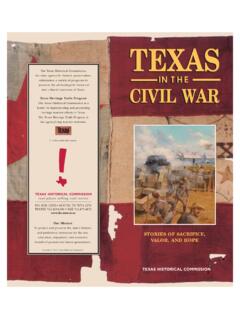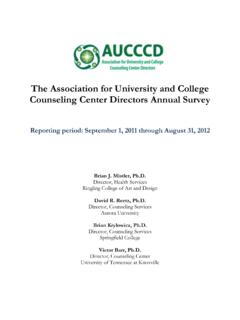Transcription of Prisoner of War Camps in Texas
1 1 Texas Historical Commission Box 12276 Austin, TX 78711-2276 Prisoner of War Camps in Texas Purpose This lesson is intended to be a quick, easy way for you to fit in important World War II TEKS that can be difficult to get to incorporate into 7th grade Texas History. It is a stand-alone lesson that could be used close to Veterans Day or Memorial Day or fit in with a unit on World War II. (It might also prove useful in 8th grade with the Language Arts unit on The Diary of Anne Frank.) The evaluation is very simple and short, but provides a way for you to check student understanding.
2 Extra resources are provided for the teacher to give background information and to use as enrichment with students if time allows. Approximate Timeframe One day TEKS (E) analyze the political, economic, and social impact of major events, including World War I, the Great Depression and World War II, on the history of Texas (A) create thematic maps, graphs, charts, models, and databases representing various aspects of Texas during the 19th, 20th, and 21st centuries (B) analyze and interpret geographic distributions and patterns in Texas during the 19th, 20th, and 21st centuries Key Understandings Students will understand how Prisoner of war (POW)
3 Camps and POW labor helped the Texas economy. Students will understand why POW Camps were located in certain geographic regions of Texas . Guiding Questions Why did so many communities in Texas want POW Camps located in them? What kind of work did POWs do in Texas ? Did POW Camps have a lasting effect on Texas ? Why is it important for people to know about POW Camps in Texas ? Vocabulary Prisoner of War 2 Texas Historical Commission Box 12276 Austin, TX 78711-2276 Materials PowerPoint 1 Two POW Camps in Texas Maps PowerPoint 2 Teacher Resources Background Information on POW Camps in Texas With nearly seventy Prisoner of war Camps , Texas had approximately twice as many as any other state.
4 These Camps ranged from extremely large base Camps that housed thousands of prisoners to small branch Camps that held less than 100. Over 50,000 German soldiers were held in Texas during World War II. While Texas as the choice to house so many prisoners of war may seem odd, the Geneva Convention stated that prisoners of war should be housed in a climate comparable to the one in which they had been captured. For those captured in Southern Europe and North Africa, Texas provided the most similar climate, according to the United states Since most young American men had gone off to fight the war, the United states faced a shortage of agricultural labor.
5 In response, the War Department authorized a major program allowing farmers in need of labor to utilize the POWs. In order to facilitate this, Texas housed 22 branch Camps , some with as few as 35 prisoners, to provide labor to farms and factories that were too far from the main POW Camps . Farmers paid the government $ a day for the POW s labor. Out of this money, the Prisoner was paid eighty cents in scrip that was only good at the camp The additional seventy cents went to the government to pay for the expenses of the POW program. From 1943 until 1945, POWs in Texas picked fruit, harvested rice, cut wood, baled hay, threshed grain, gathered pecans, and chopped cotton.
6 POWs who were not performing agricultural tasks worked projects such as the Denison Dam and Reservoir and the construction of state roads. They also served as orderlies at Harmon General Hospital in Longview and worked at Ashburn General Hospital in Useful Websites Camp Hearne: Camp Hearne: ~ Camp Hereford: German Prisoners of War: Texas World War II Camps , Prisoners of War: # Camps 1 The Battalion, Waters Describes POW Life, While many authorities agree on the climate provision of the Geneva Convention, the actual wording of the document is open to interpretation.
7 2 All prisoners were paid $3 a month, but those who worked received additional wages. 3 Michael R. Waters, Lone Star Stalag: German Prisoners of War at Camp Hearne (College Station, Texas : Texas A&M University Press, 2004), 41-42. 3 Texas Historical Commission Box 12276 Austin, TX 78711-2276 Portal to Texas History, Prisoners of War search: +of+war&t=fulltext Texas Historical Markers Enter the Atlas. Search by keyword with Prisoner of war . Or search by county and keyword. Texas Archive of the Moving Image: Alien Enemy Detention Facility, Crystal City: ,_Crystal_City,_Texas If you have specific questions, contact the Texas Historical Commission marker program and/or military historian directly at 512/463-5853 or Anticipatory Set Show PowerPoint 1 to students (If you do not have access to a computer to display PowerPoint, these photos can be printed and passed around to the students to view or pin them up temporarily on the walls for a gallery walk.)
8 Discuss what they see. Photo 1: Camp Hereford fence and guard tower Photo 2: Camp Huntsville detail of fence and guard towers Photo 3: Camp Swift funeral service for German POW Photo 4: Camp Hereford POWs harvesting vegetables Questions and Points for Discussion: Why would soldiers be picking squash? Why are there fences and guard towers around military barracks? Talk to students about prisoners of war. Where do students think this is? Photo 1 and 4 are from Camp Hereford (in the panhandle of Texas ) and the prisoners are Italians.
9 Photo 3 is from Camp Swift and the prisoners are Germans. Explore Points to discuss The Great Depression devastated Texas s economy. Almost every community looked for a way to get a government funded industry or military installation to help their economy improve. Because so many young men enlisted or were drafted into the military, there were very few left to help with agricultural work. 4 Texas Historical Commission Box 12276 Austin, TX 78711-2276 POW Camps helped the local economy because they provided employment for local citizens; the soldiers who came in with the camp shopped and sought entertainment in the local community; and the POWs could provide necessary labor.
10 Give students some of the background of POW Camps in Texas , which is provided in the Teacher Resources section. Use the maps provided to discuss the geographic location of the Camps and what kinds of agricultural work the POWs might have been doing. Share the following statistics. POW Work Statistics County reports to the Texas Extension Service revealed that 39 counties used 11,505 prisoners of war as farm laborers during 1944. These prisoners greatly contributed to agricultural production in the state. In 1944, they performed the following tasks.
